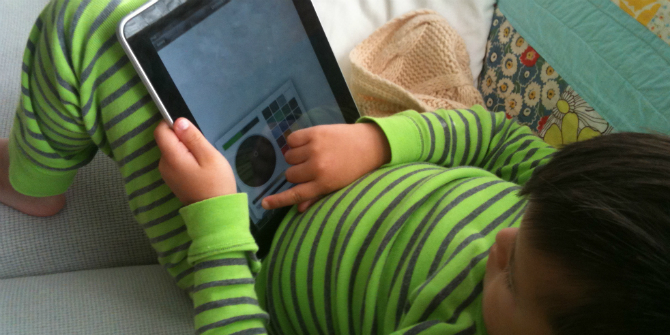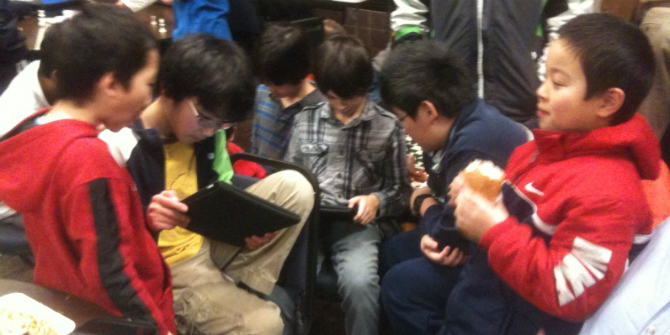 Busy educators struggle to provide opportunities to support children with disabilities to thrive online. Yet investing time in relationships to enable sharing information and cultivating digital skills and knowledge within and across communities pays dividends. For www.parenting.digital, Simon P Hammond discusses his recent research undertaken with colleagues Jeanette D’Arcy and Gianfranco Polizzi on how educators can support the connected lives of children with disabilities.
Busy educators struggle to provide opportunities to support children with disabilities to thrive online. Yet investing time in relationships to enable sharing information and cultivating digital skills and knowledge within and across communities pays dividends. For www.parenting.digital, Simon P Hammond discusses his recent research undertaken with colleagues Jeanette D’Arcy and Gianfranco Polizzi on how educators can support the connected lives of children with disabilities.
For children with disabilities, using the Internet can have great benefits, and being part of a well-connected community pays dividends. Yet, a great deal of available evidence paints a more complex story. Some educators find the use of the internet or ‘connective’ technologies by children with disabilities problematic due to the assumed negative experiences, such as exposure to online risk (i.e. bullying, sexual messaging, mis/disinformation). There is evidence to support this perspective. We know that children with disabilities are more likely to experience online risks and have these risks worsen faster than their peers. We also know that autistic children experience significantly more online safety risks, as well as psychological implications of these risk experiences, than their counterparts.
That’s it then, turn off the Wi-Fi?
Not quite. Prioritising risk over online opportunities can lead to children with disabilities being further excluded in a world demanding increasing digital participation. Social and digital inequalities are interrelated and foreground a negative cycle where digital inequalities can reinforce and/or intensify social inequalities and vice versa. For example, a lack of access and skills for using digital technologies could contribute to worse health outcomes and the widening of health inequalities.
While clearly a diverse population, many children with disabilities learn best through experience. This means that finding ways to work with risks that enhance how this population builds and shows digital resilience – that is, how to recognise, manage, and recover from risky online experiences – has great potential to help educators navigate false binaries of safe/unsafe online practices. Digital resilience involves the deployment of digital literacy skills and knowledge to learn from and grow after encountering online risk.
Critically, our recent work considers the development of digital resilience as a contextual, dynamic process that involves not only the individual but also their home, community, and societal environments. As educators operate at the level of community, they are often expected to bridge gaps between children’s homes and wider society. This means that how educators support (or not) the increasingly connected lives of children with disabilities is likely to impact how children with disabilities draw on digital resilience at a community level. What is less clear is how do educators currently negotiate this role.
Connection brokering, structural holes, and digital resilience dividends
Using this question as our starting point, my colleagues and I conducted a study, recently published in New Media & Society, aiming to understand how educators experience being part of communities that support (or not) the connected lives of children with disabilities.
We carried out 30 online semi-structured interviews with a range of professionals – 21 women and 9 men aged between 27 and 62 years (M age=43.1 years) – supporting the education, growth, and wellbeing of children with disabilities from across the United Kingdom.
We found that the ways in which educators support (or not) the digital resilience of children with disabilities related to how they as community actors were able to activate resources (such as connections to the skills and knowledge of others) to draw on digital resilience at a community level. Digital resilience at a community level was experienced as a collective property that transcends the individual educator as long as it rests on social capital– that is, the social relationships and connections that characterise a particular community.
Accordingly, educators with many “weak ties” (found in relationships with acquaintances and colleagues) reported being able to activate community resources across dispersed groups of colleagues. They were well-positioned to enable the flow of information. Educators became ‘connection brokers’ negotiating connections between a wide variety of experts to active community digital resilience resources.
When this was not the case, we found that ‘structural holes’ emerged, for example when educators reported institutional underappreciation of the importance of connectivity. ‘Structural holes’ is a term used to describe challenges that impact the efficient flow of information amongst networks. Educators primarily reported this happening when operating across professionalised boundaries and also between settings (e.g., messages from school to home, school to youth workers and vice versa). Structural holes were reported to potentially lead to restrictive mediation practices (such as regulating access to, or engagement with, digital technologies) as a limited flow of information meant that concerns about the risk of online harms to children with disabilities, as outlined above, were prioritised.
It is important to emphasise that our paper is not simply a naïve call for time-poor professionals to do more. We know that time pressures on educators are at an all-time high and growing. Yet, encouraging children to learn how to better recognise, manage and recover from online risky experiences is likely to save time spent dealing with unexpected safeguarding issues. Hence, our work shows that redistributing time to invest in addressing structural holes is likely to pay dividends in other areas within and beyond the connected lives of children with disabilities.
Community digital resilience – a collective responsibility
Educators have a deep influence on children’s lives. It is a missed opportunity if this influence is not harnessed to help children with disabilities build and show digital resilience so they can thrive in their connected lives. Importantly, supporting the connected lives of children with disabilities is a collective responsibility and one which needs investment by all those who are part of their lives. We cannot continue to risk children with disabilities being further excluded.
First published at www.parenting.digital, this post represents the views of the authors and not the position of the Parenting for a Digital Future blog, nor of the London School of Economics and Political Science.
You are free to republish the text of this article under Creative Commons licence crediting www.parenting.digital and the author of the piece. Please note that images are not included in this blanket licence.
Featured image: Photo by MART PRODUCTION on Pexels





